I initially thought about making a very big quadcopter that would be capable of lifting my weight as an ultralight personal flying device. To test the viability of the idea, I purchased two motors and motor controllers to do initial thrust measurements. These measurements were successful but the sound level, vibration, and power draw were very high so I decided to not pursue the quadcopter idea further (though such large-scale devices have been successfully built). If you are interested in a large scale flying device of this sort, I would recommend using small fuel-powered jet engines instead of electric motors. So with that idea passed over, I put together a silly project attaching the two motors onto a bicycle, so that the bicycle is accelerated by propellers. It is an inefficient and unsafe way to power a bicycle (just connect the motors to the wheel...) but it was a fun idea to test. It turns out this was not a novel idea either, as hobbyist propeller powered bycicles were built as early as 1920 and certainly many more times in the 2000s.
I carried out thrust testing with the motors and propellers. The results may be useful if you are interested in building propeller driven devices of this scale. The motors are set up axially with one motor above the other and spinning the propellers in opposite directions (which slightly improves efficiency as it reduces the rotation of the air that is thrust away). An aluminum tube holds the propellers, and a strain gauge on the tube measures the thrust force in real time, while a hall effect sensor measures the RPM of both motors, an ammeter measures total current, and a voltmeter measures the battery voltage. I get an estimate of propeller performance from the very helpful performance data made available by APC Propellers, and my thrust and RPM and power measurements on the 24x12 propeller matches their figures (for the 24x12E, mirrored here) quite closely, so that is confirmed to be a good resource for estimating thrust and power.
The motor used is a brushless 10850 size motor, 16S, 250 kv, 7 kW with ESC, which was a custom kV order supplied by "Dongguan Freerchobby Co., ltd" on Alibaba and here. The motor and ESC worked according to the specifications and the motor build quality was good, so if you are looking for a motor supplier, this company seems trustworthy. The propellers are XOAR PJA 1803 24x8 on top and 24x12 on bottom, spinning in opposite directions (pusher configuration). The pusher configuration ones were also a custom order, though the size is standard, and the propellers I received were of high quality, so I can recommend this company as well.
My notes on ending up with this design can be viewed here, and the flight duration and stress analysis spreadsheets can also be downloaded (.ods format for LibreOffice Calc).
Test results, in text format, can be downloaded as a zip file here. Note that the data is recorded in terms of hardware counts, and the conversion factors are given in the top lines of the files. A video of the spin-up and spin-down process can be viewed here (21 MB mp4) - the thrust of about 40 lbs visibly lifts the table corner and creates significant air flow in the room, in addition to being very loud. At the end of the test I rapidly changed the ESC setpoint to zero from full throttle, and the resulting inductive kick caused some small explosion from the circuit board. With the ESCs being so finicky, and the need to buy many more motors to achieve enough thrust for flight, I decided to halt the project. While I still had the motors set up, I decided to test out their thrust when placed on a bicycle.

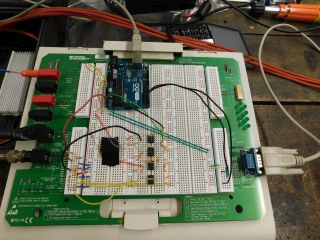

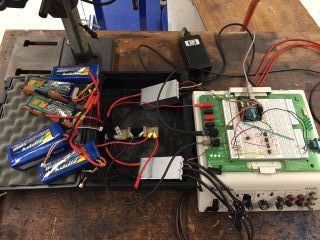
The electronics configuration for the motor and propeller test.
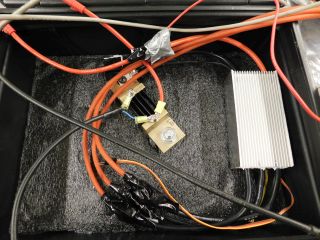
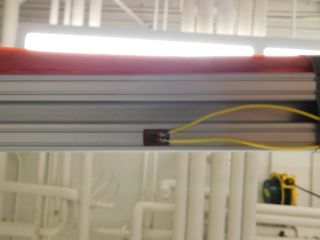
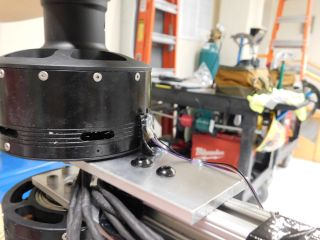
The current sensor, strain sensor, and RPM sensor.

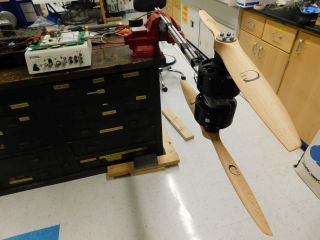
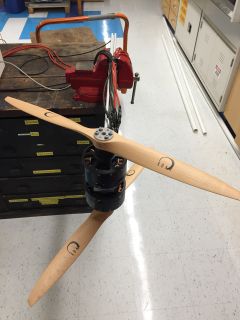
Photos of the complete test setup.
For the bicycle, I use two counter-rotating 24x12 propellers, with the 250 kv motor and only 3S battery (motor is rated for 16S) which gives a maximum 3000 rpm; with the power curve of the motor, it is likely that we will operate close to this maximum because at 3000 rpm the propeller will draw no more than 0.75 HP (from this APC page). A speed of 30 mph can be expected at which point the thrust will reduce to below 4 lbs. I suspect that with the full 16S battery configured to propel the bicycle in this way, an RPM of about 7500 could be achieved, and a speed of approximately 75 mph could be reached. The bike frame was one I found at a trash dump, and there was no chain or rear sprockets, so the only way I could move was to push with my legs or use the propellers. At least, one of the brakes was still working somewhat.
A test run of the bike confirmed that 30 mph is just barely reached in this configuration. While the propellers look and sound powerful, the acceleration is actually very gentle and soft (which I guess can be expected when you're pushing on air) and it takes up to 50 seconds to reach the top speed. If the available motor power were to be connected to the wheels directly, the top speed could be reached under 10 seconds easily. So, to no particular surprise, it is confirmed that propeller-based propulsion is not a good technique for bicycles. There was, however, a significant design flaw that I overlooked and could have led to a messy accident. This wasn't just the exposed propeller blades on either side of the bike, which make it difficult to ride on crowded city streets. Rather the way the motors attached to the bike frame had a weak point in a welded joint holding the aluminum tube to the steel structure. By the end of the test run, this welded joint bent and the propellers were tilted upwards, luckily not falling off while I was in motion. Another conclusion, then, is to follow proper engineering design and precautions even on silly projects like this.